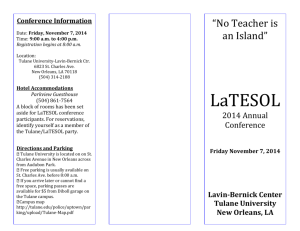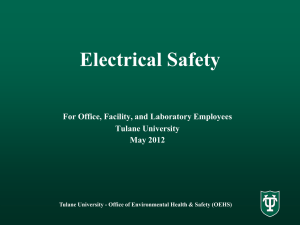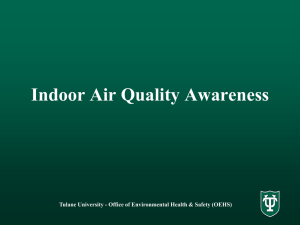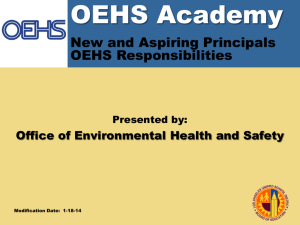General-Safety-Lab-Students-3
advertisement
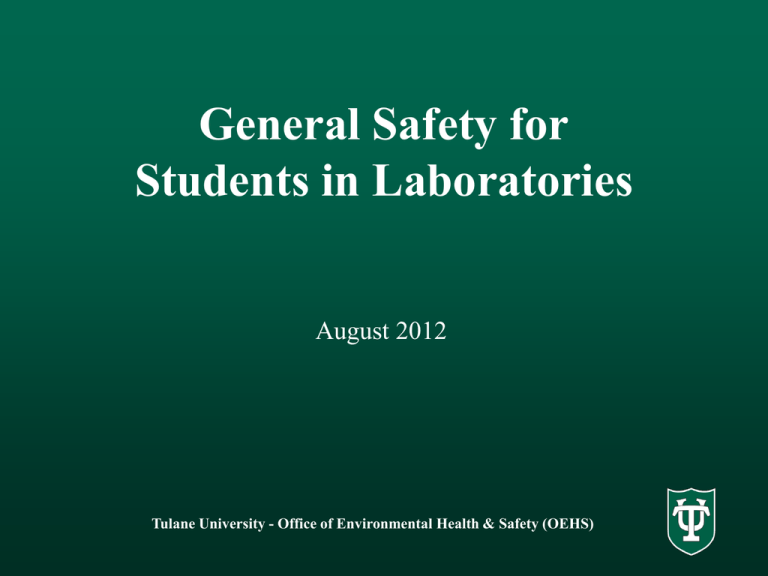
General Safety for Students in Laboratories August 2012 Tulane University - Office of Environmental Health & Safety (OEHS) Objectives for safety training • To become familiar with regulations related to laboratories •To become familiar with sources of chemical information •To become familiar with ways to detect and protect from chemical hazards •To become familiar with proper fume hood practices •To become familiar with emergency procedures Tulane University - Office of Environmental Health & Safety (OEHS) Objectives for safety training • • • • • To recognize hazardous waste To know Tulane University’s policies concerning hazardous waste To know how to properly label hazardous waste To know how to store hazardous waste To know how to minimize hazardous waste Office of Environmental Health & Safety WEBSITE http://tulane.edu/oehs Tulane University - Office of Environmental Health & Safety (OEHS) OEHS Website Topics These are some of the topics and info that can be found on the OEHS website: • Safety Data Sheets • Chemical Safety • Hazardous Materials & Waste • Fire Safety • Departmental Safety Representative Program • • • • • • Biological Safety Laser Safety Radiation Safety Ergonomics General Safety OEHS Policies & Procedures Manual Tulane University - Office of Environmental Health & Safety (OEHS) OEHS Website –Safety Data Sheets (SDS) Link • Safety Data Sheets are available on the OEHS website under the following link : http://tulane.edu/oehs/safety/materialsafetyd atasheets.cfm • SDSs are documents provided by the manufacturer that tell you about a chemical and how to protect yourself Tulane University - Office of Environmental Health & Safety (OEHS) OEHS Website - Chemical Safety Link This is some of the information available under the Chemical Safety link of the OEHS website: • Incompatible Chemical • Annual Lab Safety List Documentation Forms • Lab Hoods • OSHA Formaldehyde Standard Guide • Lab Door Labels • OSHA Hazard • Compressed Gas Communication Standard Cylinders Guide • Ethyl Ether • OSHA Lab Standard/Chemical Hygiene Plan Guide Tulane University - Office of Environmental Health & Safety (OEHS) Prudent Practices in the Laboratory National Research Council This is an excellent, highly recommended reference of laboratory safety information- now available online at http://www.nap.edu/catalog.php?record_id=12654 Tulane University - Office of Environmental Health & Safety (OEHS) Safety in Academic Chemistry Laboratories Less is Better: Laboratory Chemical Management for Waste Reduction Publications from the American Chemical Society Available online at http://portal.acs.org/portal/PublicWebSite/about/governance/com mittees/chemicalsafety/publications/WPCP_012294 http://portal.acs.org/portal/PublicWebSite/about/governance/com mittees/chemicalsafety/publications/WPCP_012290 Tulane University - Office of Environmental Health & Safety (OEHS) Hawley’s Condensed Chemical Dictionary The Merck Index Chemical Abstracts These are additional sources of chemical safety information. Tulane University - Office of Environmental Health & Safety (OEHS) Regulatory Websites These sites contain safety information and references to regulations. Some, like OSHA, even provide online training on various topics. • www.osha.gov – Occupational Safety and Health Administration website • www.epa.gov – Environmental Protection Agency website • www.bt.cdc.gov – bioterrorism site of Centers for Disease Control • www.cdc.gov/niosh - Centers for Disease Control/ NIOSH website • www.dot.gov – Department of Transportation website Tulane University - Office of Environmental Health & Safety (OEHS) OSHA LABORATORY STANDARD • Purpose: to protect laboratory workers from health hazards associated with chemical exposure in the laboratory Tulane University - Office of Environmental Health & Safety (OEHS) OSHA LABORATORY STANDARD CHEMICAL HYGIENE PLAN (CHP) • Requires a written Chemical Hygiene Plan (CHP) • See Laboratory Safety section (section 30) of the OEHS Policies & Procedures Manual Tulane University - Office of Environmental Health & Safety (OEHS) OSHA LABORATORY STANDARD CHEMICAL HYGIENE PLAN (CHP) • Tulane’s CHP is a generic plan • It is supplemented by annually updated Standard Operating Procedures (SOPs) developed by laboratory supervisors/principal investigators discussing safety practices and procedures specific to the laboratory Tulane University - Office of Environmental Health & Safety (OEHS) OSHA LABORATORY STANDARD CHEMICAL HYGIENE OFFICER (CHO) • The Lab Standard also requires each employer with laboratories to appoint a Chemical Hygiene Officer. • The certified CHO for Tulane University is Pam Fatland of OEHS. You may contact her if you have questions. Tulane University - Office of Environmental Health & Safety (OEHS) OSHA HAZARD COMMUNICATION STANDARD • Recently revised regulation (globally harmonized system of classification and labeling) • Purpose: To understand chemical hazards in the workplace and how to protect yourself • Tulane written Hazard Communication Plan located in Section 12 of the OEHS Policies and Procedures Manual Tulane University - Office of Environmental Health & Safety (OEHS) OSHA HAZARD COMMUNICATION STANDARD • Under the OSHA HAZCOM standard, manufacturers of chemicals are required to classify the chemicals they produce and transmit that information to customers on labels and Safety Data Sheets (SDSs) Tulane University - Office of Environmental Health & Safety (OEHS) Become Familiar with Chemicals in Your Laboratory • • • • • • Chemical Inventory Container Labels Laboratory Door Signs Safety Data Sheets Reference Materials Training Tulane University - Office of Environmental Health & Safety (OEHS) PURPOSE OF UPDATING CHEMICAL INVENTORY • To verify that you have the Safety Data Sheets (SDSs) you need in the work area and that OEHS library of SDSs is complete • Emergency Responders need inventory for emergencies, such as fires and spills, and for planning purposes • To perform a hazard evaluation of the area, obtain appropriate PPE, verify proper storage and that containers are in good condition and not expired Tulane University - Office of Environmental Health & Safety (OEHS) PURPOSE OF UPDATING CHEMICAL INVENTORY • Tulane is required to report inventory to local, state, and federal agencies such as the EPA, the State Police, and the Fire Department • Fees based on the inventory must be paid to regulatory agencies (Example: City of New Orleans Hazardous Materials Tax which helps to support the Fire Dept’s HAZMAT unit) Tulane University - Office of Environmental Health & Safety (OEHS) NEW CHEMICAL LABELS – Required Information • • • • • • • Product Identifier (full chemical name) GHS Pictograms Signal Words Hazard Statements Precautionary Statements Supplier Information Supplementary Information Tulane University - Office of Environmental Health & Safety (OEHS) Transfer Containers Required Information • • • • Product Identifier (full chemical name) Words, Pictures, Symbols General hazard information Specific information about physical and health hazards Tulane University - Office of Environmental Health & Safety (OEHS) NEW CHEMICAL LABELS Tulane University - Office of Environmental Health & Safety (OEHS) CHEMICAL LABELS – General Information • Required on all incoming containers, all transfer containers that will be left for a period of time, and on all containers that will be used by more than one person • You can label an entire shelf instead of each individual container if all containers on the shelf contain the same thing (Ex. specimen containers of ethanol) • Labels must be legible, in English with the full name of the chemical spelled out (no symbols or abbreviations) Tulane University - Office of Environmental Health & Safety (OEHS) CHEMICAL LABELS – Required Information • The purpose of labeling is to identify the material and to become aware of the hazards and the methods of protection • Sometimes OSHA requires special wording to appear on the label of certain chemicals or at the entrance to a regulated area (Ex. Formaldehyde containers must say “Irritant and Potential Cancer Hazard”) Tulane University - Office of Environmental Health & Safety (OEHS) Chemical Labeling Systems Optional information which may be found on a container label: • The National Fire Protection Association (NFPA) uses a colorcoded diamond with a numerical rating system to identify the degree of health (blue), fire (red), or reactivity (yellow) hazards associated with a chemical in a fire situation. A zero means minimal hazards whereas a four indicates severe hazards. Tulane University - Office of Environmental Health & Safety (OEHS) Chemical Labeling Systems Optional information which may be found on a container label: • The National Paint and Coatings Association uses the Hazardous Materials Identification System (HMIS), a similar system of labeling which rates chemicals from zero to four on their health (blue), flammability (red), reactivity (yellow), and also gives personal protective equipment designations. Tulane University - Office of Environmental Health & Safety (OEHS) Improper Labeling Tulane University - Office of Environmental Health & Safety (OEHS) Improper Labeling - Abbreviations Tulane University - Office of Environmental Health & Safety (OEHS) LABORATORY DOOR SIGNS Signage for laboratory doors stating the hazards found in the lab and emergency contact information are available from OEHS • Door sign request forms available on OEHS website at http://tulane.edu/oehs/safety/lab-door-labels.cfm – form can also be used for updates of current signs • Signs contain stickers relating to hazards found in that laboratory (Example: Flammable, Corrosive, Water Reactive) • Signs also contain authorized admittance/emergency contact information which should be used before entering a lab or during an emergency to contact appropriate personnel • Copies of signage forms are kept in OEHS for emergency response purposes Tulane University - Office of Environmental Health & Safety (OEHS) DEFINITIONS Familiarize yourself with terms found on chemical labels/SDSs SDS HyperGlossary http://www.ilpi.com/msds/ref/ Tulane University - Office of Environmental Health & Safety (OEHS) DEFINITIONS CARCINOGEN - Can cause cancer CORROSIVE - Can cause destruction of living tissue (e.g., acids, caustics) EXPLOSIVE - Can cause release of pressure, gas, and heat FLAMMABLE - Can burn when ignition source and air are present Tulane University - Office of Environmental Health & Safety (OEHS) DEFINITIONS IRRITANT - Can cause reversible inflammatory effect (e.g., eyes water, itching) OXIDIZER - Promotes combustion = oxygen SENSITIZER - Can cause an allergic reaction in some people TOXIC - Can cause health effect Tulane University - Office of Environmental Health & Safety (OEHS) Physical Hazards • • • • • Flammable Combustible Oxidizer Organic Peroxide Water Reactive • • • • • Explosive Reactive Pyrophoric Compressed gas Radioactive Tulane University - Office of Environmental Health & Safety (OEHS) Health Hazards • • • • Irritant Sensitizer Corrosive Toxic – Acute, Chronic • Carcinogen • Reproductive Toxin Tulane University - Office of Environmental Health & Safety (OEHS) ROUTES OF ENTRY Chemicals can enter the body in a number of ways. Depending on how the chemical enters the body, you may need respiratory protection, skin protection such as gloves or aprons, or face and eye protection such as face shields and goggles. • • • • INHALATION = Nose INGESTION = Mouth SKIN CONTACT = Skin, Eyes INJECTION = Skin (subcutaneous vs. dermal) Tulane University - Office of Environmental Health & Safety (OEHS) SAFETY DATA SHEETS (SDSs) • Documents that inform you of the hazards associated with a chemical and how to protect yourself from those hazards • SDSs must be readily accessible to employees in the work area where the chemicals are used • Each company publishes its own SDSs with their address and emergency contact information. Thus if you have a chemical such as acetone from two different manufacturers, you will need an SDS from each company Tulane University - Office of Environmental Health & Safety (OEHS) SAFETY DATA SHEETS (SDSs) (The following lists information that required on an SDS) • • • • • • • • Identity Hazard identification Ingredients/composition First aid measures Fire fighting info Accident release info Handling & storage Exposure controls/PPE • • • • • • • • Physical/chemical properties Stability/reactivity Toxicology info Ecological info Disposal info Transport info Regulatory info Other info/any revisions Tulane University - Office of Environmental Health & Safety (OEHS) SAFETY DATA SHEETS – ACQUISITION Ways to Obtain SDSs at Tulane: • On OEHS Website at the following link: http://tulane.edu/oehs/safety/materialsafetydatasheets.cfm • • • • • Online SDS collections Online Manufacturer Links Manufacturer FAX numbers Other University Websites OEHS Library of hard copies of SDSs Tulane University - Office of Environmental Health & Safety (OEHS) ELECTRONIC SAFETY DATA SHEETS OSHA recognizes that SDSs can be kept electronically in the work area as long as there are no barriers to immediate access. • All in work area must be trained on how to obtain SDSs • You must be able to print SDSs • You must have an alternative to obtaining SDSs in the event of power loss or other emergency (contact OEHS – library of SDSs) Tulane University - Office of Environmental Health & Safety (OEHS) OSHA LABORATORY STANDARD TRAINING & INFORMATION TOPICS The OSHA Lab Standard States that you must be familiar with the following: • Methods to detect hazardous chemicals in the work area • Signs and symptoms of exposure to chemicals • Methods to reduce exposure • Physical & health hazards of chemicals used in the work area • PPE and emergency procedures • CHP/SOPs & reference materials Tulane University - Office of Environmental Health & Safety (OEHS) OSHA LABORATORY STANDARD Detecting Hazardous Chemicals • Permissible Exposure Limits • Signs & symptoms of exposure to chemicals • Odors/Leaks/Spills • Monitoring exposure Tulane University - Office of Environmental Health & Safety (OEHS) OSHA LABORATORY STANDARD EXPOSURE CONTROL There are three main ways to control exposure to chemicals: • Engineering Controls (usually consists of ventilation, safety showers/eyewash units, etc.) • Work Practices (handling, storage, housekeeping, etc.) • Personal Protective Equipment (PPE) (gloves, eye/face protection, etc.) Tulane University - Office of Environmental Health & Safety (OEHS) CHEMICAL FUME HOODS • Designed to protect the worker from toxic or hazardous chemicals • 100% of air exhausted to outside • No recirculation of air • Baffles in back should adjust for work with chemicals of different volatilities and vapor densities Tulane University - Office of Environmental Health & Safety (OEHS) CHEMICAL FUME HOODS • All chemical fume hoods at Tulane must have an alarm or airflow indicator device on them to show that they are operating properly • Most chemical fume hoods should have a face velocity in the range of 80-100 fpm Tulane University - Office of Environmental Health & Safety (OEHS) CHEMICAL FUME HOODS • Do not assume that your fume hood is operating properly. Check the alarm indicator. At the very least, use a piece of tissue paper and make sure it is drawn inward. IF NOT OPERATING PROPERLY, DISCONTINUE WORK WITH HAZARDOUS OR TOXIC CHEMICALS! Tulane University - Office of Environmental Health & Safety (OEHS) FUME HOOD SAFETY TIPS • Keep the sash as low as possible • Work at least 6 inches inside hood • Keep work surface clear of unnecessary items • Keep baffles clear of obstructions – elevate large equipment off work surface Tulane University - Office of Environmental Health & Safety (OEHS) FUME HOOD SAFETY TIPS • Avoid rapid movement into and in front of hood • Pedestrian traffic in front of hood creates turbulence and can pull vapors out of hood and into operator’s breathing zone Tulane University - Office of Environmental Health & Safety (OEHS) FUME HOOD SAFETY TIPS • Keep the amount of material in a hood to a minimum – excessive clutter increases turbulence and reduces hood efficiency • An airfoil helps to minimize undesirable turbulence when air entering the hood impacts the front edge of the floor of the hood – be sure airfoil is installed and side panels are in place Tulane University - Office of Environmental Health & Safety (OEHS) FUME HOOD SAFETY TIPS • Secure loose lightweight objects such as paper towels • Run water in hood drains often to reduce odors that may develop in p-trap • Ensure adequate illumination in hood • Be aware that opening and closing lab doors can affect hood performance Tulane University - Office of Environmental Health & Safety (OEHS) FUME HOOD SAFETY TIPS • Keep the sash clean and unobstructed • Place cords and hoses under the airfoil so sash can be kept closed • Practice good housekeeping • Clean chemical residues and spills from interior hood surfaces Tulane University - Office of Environmental Health & Safety (OEHS) FUME HOOD SAFETY TIPS • Do not place absorbent paper under heating appliances • Do not place incompatible chemicals together • Remember – the emptier the hood, the better air currents can flow through it! Do not use hood as storage cabinet. Tulane University - Office of Environmental Health & Safety (OEHS) CANOPY VENTILATION • May be 100% Exhausted to outside, but not recommended for chemical use • Draws fumes past worker’s breathing zone • Best used for heat removal such as in a kitchen Tulane University - Office of Environmental Health & Safety (OEHS) OSHA LABORATORY STANDARD EXPOSURE CONTROL – EYEWASHES/SHOWERS • Eyewash fountains are required in work areas where formaldehyde, irritants, or corrosive chemicals are used and there is the potential for a splash to the eye. • Eyewashes must be tested weekly by the laboratory personnel. Showers must be tested at least annually by Facilities Services. Tulane University - Office of Environmental Health & Safety (OEHS) OSHA LABORATORY STANDARD EXPOSURE CONTROL – EYEWASHES/SHOWERS • Eyewash fountains are required in work areas where formaldehyde, irritants, or corrosive chemicals are used and there is the potential for a splash to the eye. • Eyewashes must be tested weekly by the laboratory personnel. Showers must be tested at least annually by Facilities Services. Tulane University - Office of Environmental Health & Safety (OEHS) OSHA LABORATORY STANDARD EXPOSURE CONTROL – EYEWASHES/SHOWERS • Emergency showers/eyewashes must be readily accessible, clear of obstructions, and clearly labeled. Tulane University - Office of Environmental Health & Safety (OEHS) OSHA LABORATORY STANDARD EXPOSURE CONTROL – WORK PRACTICES • Laboratory technique is important in minimizing exposure to hazardous chemicals. • There is no substitute for adequate planning and knowledge when using hazardous materials. Tulane University - Office of Environmental Health & Safety (OEHS) OSHA LABORATORY STANDARD EXPOSURE CONTROL – WORK PRACTICES • • • • Practice good housekeeping. Maintain aisles/uncluttered work areas. Properly store &handle chemicals. Substitute less hazardous materials when possible (such as non-mercury thermometers). • Scale down experiments. • Use secondary containment. • Use good chemical hygiene practices. Tulane University - Office of Environmental Health & Safety (OEHS) Poor Housekeeping Tulane University - Office of Environmental Health & Safety (OEHS) OSHA LABORATORY STANDARD EXPOSURE CONTROL – WORK PRACTICES • • • • • Obtaining Chemicals Transporting Chemicals Storing Chemicals Minimizing Exposure Proper Labeling Tulane University - Office of Environmental Health & Safety (OEHS) OSHA LABORATORY STANDARD EXPOSURE CONTROL – WORK PRACTICES CHEMICAL STORAGE • Minimize purchases; order only what is needed • Avoid storing on floor and in fume hood; use secondary containment • Keep containers capped and properly labeled • Practice good housekeeping • Use shelves with lips, flammable cabinets if available • Segregate by hazard class • Dispose of deteriorating, old, or unneeded chemicals Tulane University - Office of Environmental Health & Safety (OEHS) OSHA LABORATORY STANDARD EXPOSURE CONTROL – WORK PRACTICES GAS STORAGE • Properly secure gas cylinders • Make sure cylinders have protective cap in place unless attached to a regulator Tulane University - Office of Environmental Health & Safety (OEHS) OSHA LABORATORY STANDARD EXPOSURE CONTROL – WORK PRACTICES TOXIC/HIGH RISK CHEMICALS • Use in a designated area • Use containment devices such as a fume hood • Dispose of waste properly • Decontaminate work area • Have an emergency plan Tulane University - Office of Environmental Health & Safety (OEHS) OSHA LABORATORY STANDARD EXPOSURE CONTROL – PERSONAL PROTECTIVE EQUIPMENT (PPE) • PPE is used as a final alternative in the event that engineering controls and work practices do not adequately prevent exposure to chemicals. • PPE must be adequate for the substance being handled and must be available in different sizes/styles (i.e., powdered & unpowdered gloves). Tulane University - Office of Environmental Health & Safety (OEHS) OSHA LABORATORY STANDARD EXPOSURE CONTROL – PERSONAL PROTECTIVE EQUIPMENT • PPE must be inspected to make sure it is in good condition. • Personnel must be trained on PPE, how and when to use it, how to maintain and store it, etc. Tulane University - Office of Environmental Health & Safety (OEHS) OSHA LABORATORY STANDARD EXPOSURE CONTROL – PERSONAL PROTECTIVE EQUIPMENT (PPE) • A Dartmouth researcher got one drop of dimethylmercury on her latex glove and died from the exposure. Latex was not appropriate for protection for work with dimethylmercury. • Latex or PVC gloves are not suitable for direct contact with corrosive or highly toxic chemicals. • Glove permeability charts are available from glove manufacturers to help you decide which type of glove is appropriate for use with different chemicals. Contact OEHS for more information or if you have questions. Tulane University - Office of Environmental Health & Safety (OEHS) OSHA LABORATORY STANDARD EXPOSURE CONTROL – PERSONAL PROTECTIVE EQUIPMENT (PPE) • If gloves are reusable, clean and inspect them after use. Store them in a manner in which they will not become torn or damaged. • If gloves are disposable, or if they are torn or in poor condition, dispose of them in appropriate trash container. Do not throw on floor or leave dirty gloves on counters. Tulane University - Office of Environmental Health & Safety (OEHS) OSHA LABORATORY STANDARD EXPOSURE CONTROL – PERSONAL PROTECTIVE EQUIPMENT • Respirators require a medical evaluation and annual fit-testing. • Respirators should only be used if engineering and work practice controls cannot adequately control a chemical exposure. • Contact OEHS immediately if you feel a respirator may be needed in your area. Tulane University - Office of Environmental Health & Safety (OEHS) OSHA LABORATORY STANDARD EXPOSURE CONTROL – PERSONAL PROTECTIVE EQUIPMENT • Respirators require adherence to a strict respiratory protection program. • When requested, OEHS will monitor area to help determine if respirators may be required. In most cases, exposure to chemicals can be controlled by alternative methods. Tulane University - Office of Environmental Health & Safety (OEHS) OSHA LABORATORY STANDARD EXPOSURE CONTROL – PERSONAL PROTECTIVE EQUIPMENT (PPE) • Regular prescription eyeglasses do not take the place of safety glasses or goggles. • The American Chemical Society has taken the position that contact lenses may be worn in the laboratory as long as appropriate eye protection such as safety glasses or goggles, as required of other workers in the laboratory, is also worn. Tulane University - Office of Environmental Health & Safety (OEHS) OSHA LABORATORY STANDARD EXPOSURE CONTROL – PERSONAL PROTECTIVE EQUIPMENT • Safety glasses and goggles should be stored in a manner in which they will not become dirty or scratched, such as in a drawer or cabinet, or in a plastic bag. They should not be left on the counter or hung by their straps. Tulane University - Office of Environmental Health & Safety (OEHS) OSHA LABORATORY STANDARD EXPOSURE CONTROL – PERSONAL PROTECTIVE EQUIPMENT (PPE) • In addition to wearing suitable PPE, a laboratory worker must also dress appropriately for their work. For example, sandals/flip-flops, shorts, and tops with exposed midriffs are inappropriate attire for laboratory work with hazardous materials. Tulane University - Office of Environmental Health & Safety (OEHS) OSHA LABORATORY STANDARD EMERGENCY PROCEDURES In the event of an emergency: • Evacuate the area • Contact Public Safety and OEHS immediately • Be familiar with your Emergency Action Plan (EAP) – evacuation policy, procedures, and escape routes – see your Departmental Safety Representative for more information Tulane University - Office of Environmental Health & Safety (OEHS) OSHA LABORATORY STANDARD EMERGENCY PROCEDURES – FIRE SUPPRESSION Before using a fire extinguisher: • Make sure you have an unobstructed escape route at your back • Fire should be small, confined, and not spreading (e.g., trash can fire) • Know that the extinguisher is the right type for the job • Know how to use an extinguisher Tulane University - Office of Environmental Health & Safety (OEHS) OSHA LABORATORY STANDARD EMERGENCY PROCEDURES – FIRE SUPPRESSION To use a portable fire extinguisher, remember PASS: • Pull the pin • Aim the nozzle at the base of the fire • Squeeze the handles • Sweep from side to side Tulane University - Office of Environmental Health & Safety (OEHS) OSHA LABORATORY STANDARD EMERGENCY PROCEDURES – FIRE RESPONSE HOW TO RESPOND TO A FIRE IN YOUR AREA FOLLOW THE ACRONYM, E S C A P E E = EVALUATE the situation S = SECURE THE AREA – Remove occupants C = CLOSE THE DOORS to contain the fire A = ACTIVATE THE FIRE ALARM – use the nearest pull station P = PHONE THE DESIGNATED EMERGENCY NUMBER Uptown Campus – dial 865-5200 or X5200 E = EXTINGUISH THE FIRE – using a portable fire extinguisher, if you determine it is safe to do so (fire is small and not spreading, fire doesn’t come between you and the exit, etc.) Tulane University - Office of Environmental Health & Safety (OEHS) BUILDING BLOCKS OF LABORATORY SAFETY • Make safety a top priority • Make information available and accessible (SDSs, safety literature, etc.) • Use equipment appropriate for the task • Be watchful during experiments – be ready for unexpected events • Substitute less hazardous substances when possible, or use other methods such as robotics Tulane University - Office of Environmental Health & Safety (OEHS) BUILDING BLOCKS OF LABORATORY SAFETY • Avoid close calls and doing something “just this once” • Do not procrastinate (get equipment repaired, buy needed PPE, etc.) Tulane University - Office of Environmental Health & Safety (OEHS) What is a Hazardous Waste? Characteristic Waste: A substance that meets the EPA classification(s) for any or all of the following characteristics (40 CFR §261 Subpart C); • Ignitability • Corrosivity • Reactivity • Toxicity Items received with hazardous shipping labels will most likely become hazardous waste Tulane University - Office of Environmental Health & Safety (OEHS) What Is A Hazardous Waste? Listed Waste: Waste that the EPA has listed as “hazardous” regardless of its physical characteristics. • Commercial Chemical Products ( P and U Lists) – P- List (40 CFR §261.33(e)): “acutely hazardous” wastes (e.g. physostigmine, sodium azide, strychnine) – U-List (40 CFR §261.33(f)): “non-acutely hazardous” wastes (e.g. formaldehyde, xylene, toluene) Tulane University - Office of Environmental Health & Safety (OEHS) P and U Lists • P-Listed wastes are highly toxic; could be or are fatal to humans and animals in low doses • U-Listed wastes are toxic, but not considered acutely toxic; carcinogens, mutagens, materials that bioaccumulate – Chemicals on the P and U lists are generally “toxic” but can also be ignitable, corrosive, and reactive Tulane University - Office of Environmental Health & Safety (OEHS) What is a Hazardous Waste? Listed Waste Cont’d: • Process Wastes: Wastes from various sources that EPA has determined should be regulated as “hazardous.” ( F and K lists) – F- List (40 CFR §261.31) : wastes from non-specific sources (e.g. spent solvents) – K-List (40 CFR §261.32) : industry specific wastes Tulane University - Office of Environmental Health & Safety (OEHS) How Do I Know if my Waste is “Hazardous?” • Properly characterizing waste streams can be a complicated process, and must be done accurately to ensure that waste is properly treated and disposed. • Please contact OEHS (504) 988-5486 for questions regarding whether or not your waste is “hazardous.” Tulane University - Office of Environmental Health & Safety (OEHS) What Is A Hazardous Waste? Check the Safety Data Sheet to help determine if your waste chemical is a hazardous waste Tulane University - Office of Environmental Health & Safety (OEHS) What Is Hazardous Waste? Any of these keywords usually indicate the waste materials will be hazardous waste: • Flammable • Stench Agent • Flashpoint (<140 F) • Oxidizer • Corrosive, Acid, Basic, Caustic (pH <2 or >2.5) • Water or air Reactive, Pyrophoric, Peroxide Former • Explosive • Poison Tulane University - Office of Environmental Health & Safety (OEHS) Empty Containers Generally speaking, empty containers are not considered “Hazardous Waste” and may be thrown away with regular solid waste or in a glass disposal box only after the label has been removed or defaced. Tulane University - Office of Environmental Health & Safety (OEHS) Rinsing Empty Containers However, empty containers that previously held “acutely hazardous waste” (P-listed waste) must be triple-rinsed with an appropriate solvent before disposal. The solvent must then be disposed of as a “Hazardous Waste.” Contact the OEHS (504) 988-5486, to determine if you are working with any “acutely hazardous” materials. Tulane University - Office of Environmental Health & Safety (OEHS) Accumulating “Hazardous Waste” • Capture waste in rigid containers that are compatible with the waste. • Keep all containers closed (capped) except when hazardous waste is being added to them. • Do not store incompatible wastes together. • Outer containers should be clean and free of residue Tulane University - Office of Environmental Health & Safety (OEHS) Accumulating “Hazardous Waste” • Use Eco Funnels when possible to reduce emissions Tulane University - Office of Environmental Health & Safety (OEHS) Accumulating “Hazardous Waste” Use secondary containment such as a tray or a tub to contain hazardous waste in the event that the primary container should leak. Tulane University - Office of Environmental Health & Safety (OEHS) Containerize Hazardous Waste • Cans of paint without lids, broken thermometers, and chemically contaminated items must be overpacked into another container which is free of leaks so they can be disposed of safely. • The OEHS will not accept waste that is not properly containerized. Tulane University - Office of Environmental Health & Safety (OEHS) To Help Minimize Costs DO NOT MIX WASTES • Only compatible waste solvents should be mixed together in appropriate waste containers • Do not mix acids and flammable materials together • Do not mix biological and chemical waste • Do not mix radiological and chemical waste These practices can greatly reduce the cost of hazardous waste disposal. Tulane University - Office of Environmental Health & Safety (OEHS) Labeling Waste Containers The following information must be on the label: • The words “Hazardous Waste” • The full name of the chemical(s) being placed in the container (no abbreviations or symbols) • Associated hazards (such as flammable, corrosive, reactive, toxic) Tulane University - Office of Environmental Health & Safety (OEHS) Labeling Waste Containers (cont’d) Do not rely on the EHS Specialist picking up your waste to label your containers for you. It is the waste generator’s responsibility to properly identify and label waste and waste containers. The OEHS provides “Hazardous Waste” labels upon request. The OEHS does not accept unknowns or unlabeled waste for disposal Tulane University - Office of Environmental Health & Safety (OEHS) “Hazardous Waste” Disposal Procedures • Maintain waste in your area until collected by OEHS or brought to the OEHS storage facility. • To schedule a waste pickup, submit an online “Hazardous Waste Pickup Request Form;” http://tulane.edu/oehs/hazard/hazwastepickuprequest.cfm. •Please allow ~ 1 week from the time of form submission to have your waste picked up. Tulane University - Office of Environmental Health & Safety (OEHS) “Hazardous Waste” Disposal Procedures • Tulane is not a licensed disposal facility - NEVER dispose of “Hazardous Waste” by pouring it down the drain or placing it in the trash. • Do not use evaporation as a disposal method. • Under no circumstances may anyone place chemicals in the OEHS waste storage areas unless directed by OEHS personnel. Tulane University - Office of Environmental Health & Safety (OEHS) Disposal Costs • The OEHS is responsible for the cost of disposal associated with chemical waste from laboratories and other areas that is generated through normal research and work activities. • The OEHS is not responsible for the cost of disposing of unwanted/old chemicals from principle investigators/researchers/others separating from the University. Tulane University - Office of Environmental Health & Safety (OEHS) Lab Cleanouts • Any department which needs disposal of chemicals that are generated due to a lab or other area closing down or being renovated must bear the cost for disposal of those chemicals. • OEHS must receive a signed IT before it makes any arrangements with a commercial disposal company for removal and disposal of such chemicals. • You must go through OEHS for disposal of all “Hazardous Waste”. Contact OEHS for estimates if needed. Tulane University - Office of Environmental Health & Safety (OEHS) Minimizing “Hazardous Waste” By law, a Waste minimization program is required. Waste minimization is accomplished by: • Source reduction (ordering less & only what is needed) • Surplus chemical redistribution • Labeling all containers (disposal of unknowns is expensive) • Redistilling solvents • Using mercury-free instruments • Substituting hazardous chemicals with non-hazardous or less hazardous chemicals • Reducing the scale of experiments Tulane University - Office of Environmental Health & Safety (OEHS) Chemical Waste Handling Procedures • For a poster on chemical waste handling procedures which can be placed in your lab or other area for convenient reference, please go to the following link: http://tulane.edu/oehs/hazard/upload/ChemWasteProce.pdf Tulane University - Office of Environmental Health & Safety (OEHS) Radioactive Waste Radioactive waste is regulated separately from “Hazardous Waste” by the Nuclear Regulatory Committee (NRC). For questions regarding radioactive waste, contact the Radiation Safety Officer (RSO), Charles Reindl, at 988-2867 or email creindl@tulane.edu. Tulane University - Office of Environmental Health & Safety (OEHS) Medical Waste Medical waste is regulated by the EPA, but collection and disposal of medical waste is coordinated through Facilities Services. Please contact Facilities Services on your campus for questions regarding medical waste and to schedule pick-ups. Tulane University - Office of Environmental Health & Safety (OEHS) Waste Disposal Summary • Those who generate “Hazardous Waste” must adhere to Tulane University’s Policies & Procedures concerning hazardous waste. • All “Hazardous Waste” must be properly accumulated, labeled, and disposed. • “Hazardous Waste” generation can be minimized by using less toxic materials, substituting the hazardous material with non-toxic material, or recycling the material. Tulane University - Office of Environmental Health & Safety (OEHS) Tulane University Office of Environmental Health & Safety (OEHS) Pam Fatland Manager, Safety (504)988-2800 / (504)988-2865 pfatlan@tulane.edu / mkopaigo@tulane.edu Proceed to Quiz If unable to proceed to quiz, type the link below into your browser https://audubon.tulane.edu/ehs/enterssn.cfm?testnum=127
